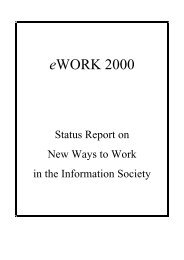1996 - European Telework Week
1996 - European Telework Week
1996 - European Telework Week
- No tags were found...
Create successful ePaper yourself
Turn your PDF publications into a flip-book with our unique Google optimized e-Paper software.
<strong>Telework</strong> 96<br />
Global trends such as digitisation, miniaturisation, higher bandwidth (images and<br />
colour), allowing greater use of portability, and the integration of "converging"<br />
technologies will lead to a decrease of costs and greater user friendliness of multimedia<br />
communications and services. Their implementation will multiply the legal and moral<br />
issues. The social impact of media is an active process which involves both the people<br />
articulating the information flow and the ones that use the end result.<br />
The use of media is context dependant and it takes several forms at an individual level:<br />
• the home equipment, type of housing, and type of neighbourhood;<br />
• the household family structure and social behaviour;<br />
• individual values and cultural habits which inter-relate with the taste in, and<br />
acceptability of material;<br />
• the individual purchasing power and the breakdown of the expenditure (in particular<br />
the disposable income for leisure activities and for cultural spending);<br />
• the type of professional activity, linked to use of information and communication<br />
technologies at work, and to person-to-business use of media.<br />
Moreover, the diffusion of each new communication medium is based on the progressive<br />
development of an effective use which may be significantly different from the anticipated<br />
one. At a collective level, use of media is inter-twined with social trends. Acceptance of<br />
new media will depend on the flexibility of social settings, and organisations, and the<br />
nature (in terms of speed, and intensity) of the structural adjustments the community has<br />
to undertake because of new technologies.<br />
Familiarity with audio-visual equipment<br />
The penetration of TV, telephone lines and VCRs in Europe’s households is already<br />
high. In 1991 20.8% of the household in Europe already had a PC at home. Looking at<br />
shipped PC units it is clear that PC penetration has increased:<br />
EC 1992 1993 1994 CAGR '92-'94 %<br />
PCs - professional market 5,618,000 6,026,000 6,453,000 7.2<br />
PCs - home market 2,543,000 2,722,000 2,888,000 6.6<br />
Source: International Data Corporation<br />
PC units shipped in the <strong>European</strong> Community<br />
In 1992 telecom revenue already represented about 2% of the EU gross domestic product<br />
(10% growth compared to 1991). The penetration grade of cellular phones has grown<br />
between 1988 and 1993 with more than 40%.<br />
Traditional media (cinema, press and books) change. More screens with smaller<br />
audiences per screen in cinema’s, less reading, especially with the less educated young.<br />
Over the past few decades, converging phenomena have tended to renew the social<br />
environment on which the use of media acquires its significance. The change from mass<br />
broadcast systems to a mix with narrow-cast and interactive media, which will stimulate<br />
the diversity of views, will have a major influence on socio-political trends. However, it<br />
- 27 -








